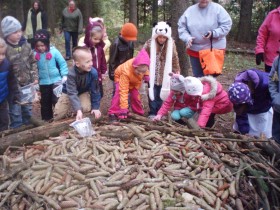 As kindergarten students learned last week at Crossroads at Big Creek, red squirrels are frantically harvesting food for winter. Actually, during the class field trip, cones were dropping from the spruce trees. Perhaps the red squirrel was throwing the spruce cones in order drive the “intruders” from his territory or maybe he merely was nipping twigs so he could collect cones on the ground. But the children were convinced that the squirrel was aiming at them. [Nobody got hit, but then, kindergarten students are moving targets!]
As kindergarten students learned last week at Crossroads at Big Creek, red squirrels are frantically harvesting food for winter. Actually, during the class field trip, cones were dropping from the spruce trees. Perhaps the red squirrel was throwing the spruce cones in order drive the “intruders” from his territory or maybe he merely was nipping twigs so he could collect cones on the ground. But the children were convinced that the squirrel was aiming at them. [Nobody got hit, but then, kindergarten students are moving targets!]
For squirrels, late summer and fall is the time of gathering. Certainly, all squirrels collect food. Grey squirrels bury their finds, one nut at a time. But red squirrels create middens. A red squirrel midden is a combination of a food drier, a storage area, a dining room table, and a solid waste disposal area. In the evergreen forests of Door County, the squirrel middens can be huge….collections of cones interspersed with the scales and the cobs which were discarded in past winters. Presumably because they feel safer when slightly elevated as they pull scales from cones and devour the seeds, squirrels usually make their middens under or near a prominent stump or log. This probably makes it easier for the squirrels to locate their stored cones after a heavy snow.
This fall, a red squirrel found a midden site that was both elevated and prominent. Years ago, participants in a summer art program worked collaboratively to create a giant nest in the spruce forest just east of the Collins Learning Center. The installation is starting to decompose, but still looks like nest or a really big bowl. At least one red squirrel thought it looked like a storage bin so he filled it with thousands and thousands of cones. Unless he becomes a meal for an owl or fox, this red squirrel will likely survive even the longest winter.
But it’s damp in the forest, in the “nest” and on the ground. I had always wondered about the wisdom of storing food in a dank place like a forest floor. Turns out, this indeed is prudent. Dry cones open their scales and seeds drop out. By caching the spruce cones in only moist places, red squirrels ensure that each cone will contain a generous helping of seeds .It’s kind of a cache reserve.
“Meet the Red Squirrel” will be the Crossroads Family Program on Saturday, November 9. At 2:00, a short indoor slide program will introduce learners of all ages to this industrious native mammal. Following the slides, the group will hike to several of the evergreen forests at Crossroads in search of middens and the little squirrels which create them.
On Sunday at 4:00, folks are encouraged to get off the couch and celebrate the Packer win by walking for about an hour through the green and gold forests a Crossroads. Learn how trees are adapted to survive winter.
 As kindergarten students learned last week at Crossroads at Big Creek, red squirrels are frantically harvesting food for winter. Actually, during the class field trip, cones were dropping from the spruce trees. Perhaps the red squirrel was throwing the spruce cones in order drive the “intruders” from his territory or maybe he merely was nipping twigs so he could collect cones on the ground. But the children were convinced that the squirrel was aiming at them. [Nobody got hit, but then, kindergarten students are moving targets!]
As kindergarten students learned last week at Crossroads at Big Creek, red squirrels are frantically harvesting food for winter. Actually, during the class field trip, cones were dropping from the spruce trees. Perhaps the red squirrel was throwing the spruce cones in order drive the “intruders” from his territory or maybe he merely was nipping twigs so he could collect cones on the ground. But the children were convinced that the squirrel was aiming at them. [Nobody got hit, but then, kindergarten students are moving targets!]

